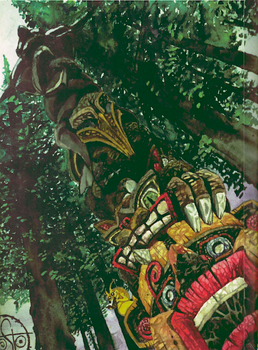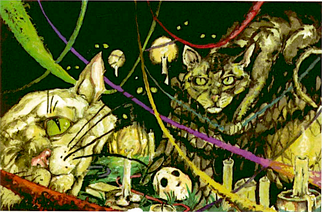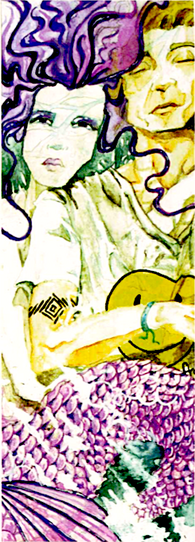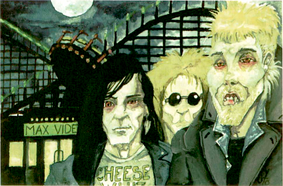Terebinthea is both a Freehold of the Kithain and Tradition Chantry in the Kingdom of Pacifica.
Overview[]

The freehold of Terebinthea is one of the most confused and yet most hopeful projects known to fae history. Above the University of California, Santa Cruz is situated a beautiful sylvan glen known as Elfland, the splendor of which has, unfortunately, been shattered by university expansion; specifically, the building of a ninth college. Though not yet wholly destroyed by the encroaching civilization, Elfland’s days are numbered; it is merely a matter of time before the wooded castle of enchantment fades from the Dreaming.
It is for this reason that a new freehold has been created, deeper within the shadows of the redwood forest. Though possessing none of the natural splendor of the glen of Elfland, this freehold, known as Terebinthea, is an attempt to salvage some of Elfland’s fading Glamour. If the architects are inspired to design a structure of grace and beauty, and the redwoods circles are not totally destroyed, some of the Glamour of lost Elfland may be preserved, and the woodland palace that surrounds the hall of learning may flourish once again.
Terebinthea & Elfland[]

To the north of U.C. Santa Cruz, a path leads from one of the fire trails behind the Crown-Merrill apartments, and heads northwest to Elfland. Students have been coming to the redwood cathedrals of Elfland since the early sixties. In keeping with tradition, they bring some trinket to leave “for the elves;” thus, many of the stumps and trees are festooned with glass beads and candlewax and other small items given as offerings. Small hand-painted signs designate sites along the trails, such as Dragon’s Den (a hollow under the roots of a redwood amid a series of pools), the Council Chamber (a redwood cathedral with a throne shaped stump), the Bridge to Heaven and the Descent into Hell (a redwood fallen to create a living bridge across a deep gorge), the Grove of Mirrors (a smaller redwood circle with chips of mirror placed into the bark of one of the trees), Gnome’s Path, and various others. Different groves have blankets, candles, corkscrews, and books of poetry left out for visitors to use and enjoy.
Unfortunately, many of the lesser sites have not been destroyed, and orange slashes mark other trees of the redwood circle for future decimation. In consequence, measures have been taken to move Elfland freehold to a safer haven deep within the forest.
This new freehold is named Terebinthea. The smaller trinkets and talismans from Elfland will be rescued and taken here, a place where Glamour may run free and beauty will remain untouched. In the center of Terebinthea stands a totem pole, surrounded by a circle of stones, with four tokens placed around it to represent the four elements: a shell for water; a feather for air; a candle for fire; and a stone for earth. The totem pole, which dates back to the 1960s, once stood in a plywood maze in the Cowell Meadow. When the maze was destroyed, the pole was stolen and moved from place to place by successive generations of students. At one point, it came into the hands of the University administration, who planned to erect it publicly at one of the colleges, like the larger poles in the Porter Quad. A bold group of young students managed to steal it back, however, and brought it to Terebinthea, where it was reconsecrated.
Near the totem pole is Cat’s Cradle, a tiny den nestled within a circle of redwoods, created by a web of interwoven tree branches. Visitors place statuettes and amulets of cats in various niches, thus transforming the small glen into a shrine to felines. Many other such sites are in the process of creation nearby.
When clothed in the Glamour of dreams, Elfland is a forest castle of fallen splendor, its walls breached and torn apart by the bulldozers of university expansion. Each of the sties; the Council Chamber, the Grove of Mirrors… lies in elegant disrepair, the rich and beautiful chimerical tapestries and furnishings now transferred to the new Palace of Dreams. An old and sickly chimerical dragon lies in its den before the enchanted pool, once a wellspring for the stream that meanders through the glen. Refusing to move, the dragon comes closer to death each day as the Glamour in the pool either dries up or is diverted to the new freehold.
Terebinthea, to fae site, is still under construction, a new chimerical castle with bits of the old included in each of the chambers and fortifications. Cat’s Cradle is already complete: a glorious shrine to dreaming eyes, spun about with chimerical yarn of all colors and home to dozens of chimerical cats and kittens. The totems on the totem pole can speak as well, though they seldom will to those who do not respect the old dreams of the land.
Even to immortal eyes, though, the fae castle is a strange spectacle, not only because the dreams are new, but because its construction is comprised of such an interesting mix. The creation of Terebinthea, and the salvage of Elfland, has been the work of mages as well as changelings, and this is most clearly reflected in the architecture. Mage magick has made the totem pole into the new wellspring, or node, of the freehold, diverting Glamour (Quintessence to mages) to the new site via manipulation of the ley lines and enchantments on the pole.
Terebinthea is also heavily warded against vampires, werewolves, and most spirits, though not, of course, against faeries or witches. A Kenning roll is necessary for changelings to recognize the witch-weavings, though a subsequent Occult roll must be made to fathom their true purpose. In order for a vampire, werewolf, or wraith to enter the freehold, the wards must first be opened or broken, and these wards are quite potent.
According to the records kept at the nearby Scottish castle in Bonny Doon, one of High King David’s western holdings, the ruler of Terebinthea is Lady Gwynhyfar Mira, a sidhe noble of House Eiluned. According to the sidhe, Lady Mira has recently named a young troll, Peter Oslo, as her Champion. Lady Mira is also said to keep a very private, and rather eccentric, court. She hosts no revels apart from a Midsummer pageant at the Santa Cruz Beach Boardwalk, and keeps out of sidhe politics as much as possible, both Seelie and Unseelie. All others at Terebinthea are listed as her chamberlains and stewards, personages of little importance to fae politics.
As is often the case with House Eiluned, the truth is, of course, rather different. Lady Mira has used her sidhe patents and peerage to keep the Court of King David, and the rest of the sidhe nobility, out of Terebinthea’s hair, while she holds court in her own fashion and her people work to salvage Elfland. For purposes of internal politics, Lady Mira has already abdicated the rulership of the freehold, such as it is, and taken for herself the role of Steward, while Peter has become Lord, since the general feel of the place is more like an anarchist collective than any true Household.
The Fey Circle[]

The Terebinthea freehold is unique in that the Kithain who make this their home also share it with a mage Chantry. This group, known as the Fey Circle, is led by Dustin Carver, who also serves as an advisor to Lord Peter.
Most of the Circle practice the faerie tradition of Witchcraft, a path of magickal learning involving Celtic and Teutonic fae charms, though the group also includes a Son of Ether, a Virtual Adept, and a Hollow One. Not all members of the Chantry actually accept the existence of the fae; indeed, many strongly question Dustin’s sanity, though none would dare oppose him as long as he continues to supply the Chantry with Quintessence. In the past, relationships were strained, especially over the issue of rightful shares of Glamour/Quintessence; however, since the destruction of Elfland, both mages and changelings have come to realize that the only way to save any of the enchantment is to work together, and what stands now is a sense of solidarity, if not community.
Each member of the coven is a distinct personality. These include: Olive Whitethorn, a very pretty, very New Age, and very traditional Verbena witch and Adept of Life and Time magicks, who believes both in faeries and in Dustin; Bartholomew “Barry” Heidecker, a tall, blond physics grad student, and student of Mind and Spirit magicks, who had built optical sensors that can detect chimera (which, in typical Son of Ether fashion, he refers to as “hallucinatory anomalies”); Jim Grover, a political activist and part-time eco-terrorist who talks to trees and who, with Life and Forces, can get them to listen; Petula Martlett, a newly Awakened Verbena and Afro-American women’s rights activist who is quite certain Dustin is insane; Caitlin Amber, a Virtual Adept and techno-pagan, who doesn’t believe in faeries, but is willing to play along for the sake of politics; and Gordon “Eightball” Geary, a Hollow One who is on the run from the Men in Black, the Nephandi, and several demons, and who desperately wants to believe in changelings and anything that might save his life and soul.
Of the mages, only Dustin, Olive, and Barry can recognize changelings for what they are, and Barry requires scanners, goggles, and oscilloscopes, and thus is easy to avoid. Gordon is highly sensitive, but differently attuned: he is able to sense changelings as Awakened beings, but is unable to perceive their fae seemings. However, as a result of his infernal dealings, he has an instinctive distrust of the Unseelie and can sense their legacies. By use of an old Eightball, he can also perform divinations of startling accuracy.
Petula and Caitlin have no fae affinity and generally believe the changelings of the area to be delusionary at worst and Marauder hedge magicians at best. Jim Grover, however, is an actual Marauder, though, because his delusions coincide with much of normal and fae reality, no one has figured it out yet.
Outside Relations[]

Situated on the California coast just south of San Francisco, Santa Cruz is a crossroads, physically and spiritually, and as such is as popular with the supernatural of the World of Darkness as it is with the banal mundanes. The quintessential surf town’s name means “Holy Cross,” and this is exactly what it is: a nexus of dreams and spiritual energy, as much from the population who lives and visits there as from the paths of the ley lines.
Brujah vampires, either inspired by the movie The Lost Boys, or the inspiration for it, cruise the Santa Cruz Beach Boardwalk regularly, at least in the summer months. This causes some friction with the local changeling population because the sidhe, by tradition, consider the Boardwalk to be Festival Grounds, a place for the trooping faeries of both Seelie and Unseelie courts to set up their pavilions and engage in parades, pomp, and pageantry. Of course, while fae Glamour may spin the Giant Dipper and the Loof Carousel into crystalline confections of dreams and delight, this generally goes unnoticed by the bloodsuckers (except for those of the Toreador clan), so most direct conflicts are avoided.
A large pack of Fianna werewolves live in Boulder Creek, farther up in the Santa Cruz mountains. Of greater importance, though, are the ruins of Mission Santa Cruz in the square before Holy Cross Church. This, along with numerous murder sites around town, has become a haunt for wraiths. (Santa Cruz was, at least at one time, the murder capital of the world, as several serial killers operated there at once. The City Council, not wishing to publicize this, insisted the town be renamed Santa Carla in The Lost Boys.)
The major draw for the supernatural, though, is the Camino Real, the “Royal Road”: a series of ley lines mapped out in the early days of European conquest, linking all of the California Missions together in a chain of power. The Portola Party marked the ground for Mission Santa Cruz on the site that is now the Holy Cross Church. The Ohlone natives who were caught here and forcibly impressed into Christianity died of dysentery, malnutrition, and other ills, as did the rest of the Native Americans subjected to the horrors of the Missions. Their wraiths still haunt the Camino Real.
In banal reality, the Camino Real is Mission Street, but to the fae, as well as to mages, it is truly the Royal Road, a path which can be picked out clearly and easily with fae Kenning or mage Awareness. There is just as much dark power here as light, though; among the Unseelie, it is whispered that, when the Mission bells ring, the wraiths of those murdered by the holy fathers are led up and down the road in chains.
Denizens[]
Chimera[]
The Court[]
Commoners[]
References[]
- CTD. Freeholds & Hidden Glens, pp. 111-123.
